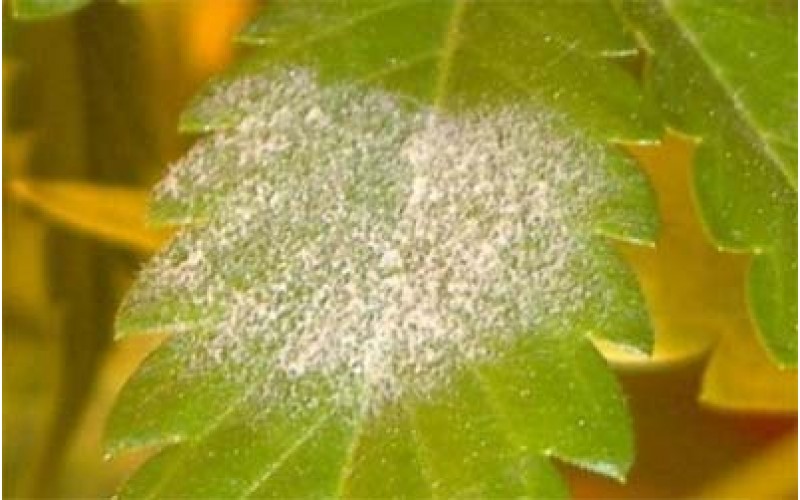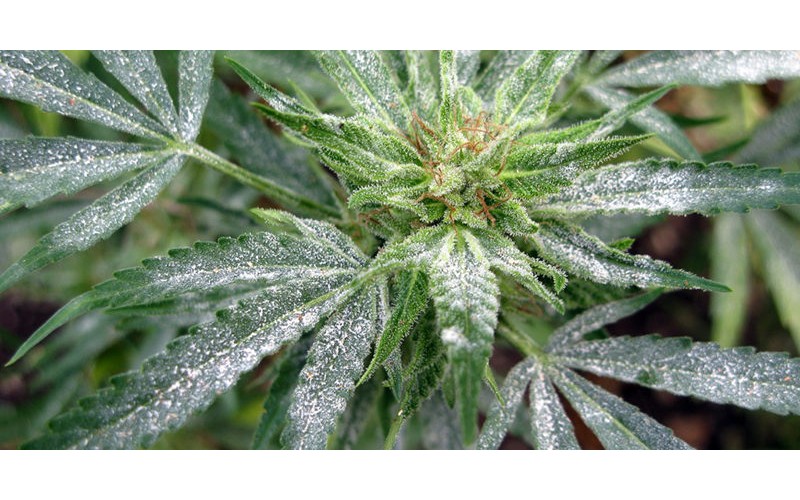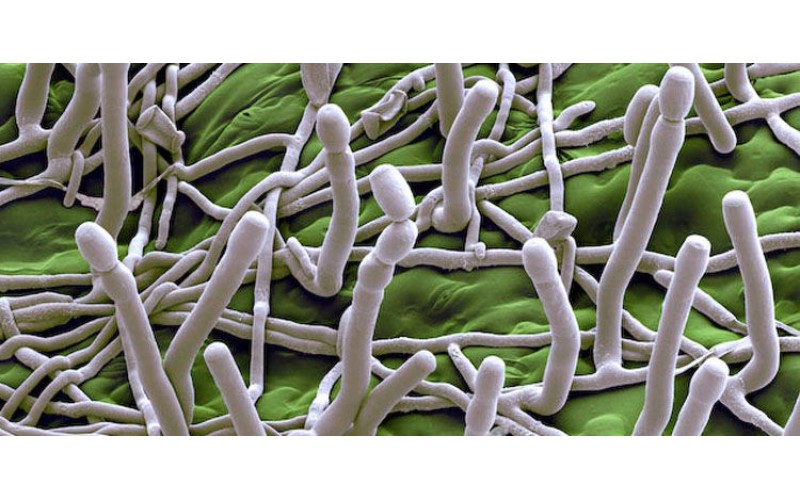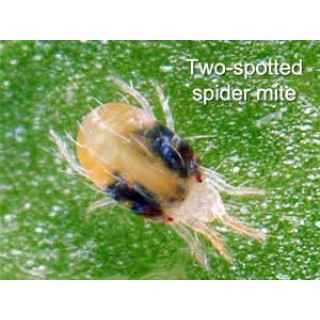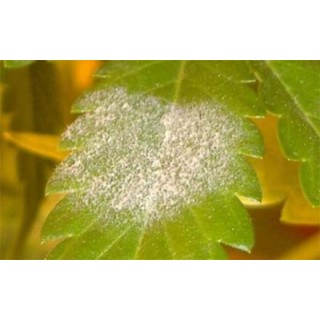Growroom Problems - Mildew
Spores
How do I Recognize, Control, and Prevent Powdery Mildew?
Introduction
- Powdery mildew is a common fungal disease that can seriously damage indoor and outdoor crops.
- Powdery mildew can rapidly infect crops in both vegetative and flowering stages, coating leaves, stems and buds in fungus.
- Powdery mildew typically thrives in cool, damp, shaded and poorly ventilated areas. Airborne spores brought into the grow room land on leaf surfaces and will germinate given favorable conditions. High night humidity levels often trigger the growth of mildew spores. Powdery mildew can attack indoor crops year round. Powdery mildew is almost impossible to stop in late flowering, so early detection and control is essential.
Identification & Recognition:
- Identification: Symptoms and damage: Early signs of powdery mildew include white powder/fuzzy patches on leaves (usually low in the canopy) and a fuzzy white coating on lower stems. Note: powdery mildew can be wiped off the leaves for a quick visual check.
- These fuzzy mycelium patches produce airborne spores that rapidly attack adjacent plants; mildew will eventually coat leaves and entire plants, reducing photosynthesis, plant vigor and bud quality.Mildew-Prone Gardens, Plants & Environments:
- Perpetual harvest, dense scrog/sog systems, and damp basement grows are particularly vulnerable to powdery mildew. Note: strains vary in their susceptibility.
- Plants on the edge of a garden, in corners and under stress are attacked first; infection usually starts in the lower canopy where conditions are optimal. As infection progresses, mildew will spread to the top of the plants and finally attack the buds.
- Powdery mildew is favoured by dry atmospheric and growing conditions, moderate temperatures, reduced light intensity, good nutrition and succulent plant growth.
- For this reason it is a very common disease in later summer and Autumn (Fall), but it can be a problem in protected growing areas such as greenhouses, conservatories and grow rooms, on a year round scale. All mildew spores are spread via wind or air movement, and certain insects can also carry the disease.
- Unlike other fungal diseases, such as downy mildew, the powdery mildew spores don’t require a film of water to be present on the leaf surface to germinate and infect the plant tissue. In fact, if the powdery mildew spores are in contact with water they are inhibited to a certain extent. mediumer growers can achieve some control over powdery mildew by simply spraying the leaves with a garden hose in the afternoon to help prevent infection. Powdery mildew spores germinate best in a temperature range of around 22 – 31 C (72-88F), and in shaded areas of the crop, so it is more severe in closely planted crops. If the spores, entering a growing area, make contact with a plant under conditions of reduced light intensity, a temperature of 22 – 31 C (72-88F), and absence of moisture then germination will occur within two hours, and infection will be two days later.
Infection, Indication & Effects:
- Infected buds may appear normal; but are internally dusted with white powder (which cannot be removed by drying), and have a stale, musty/moldy smell when dry. Smoking or trimming infected buds can cause sickness and lung infections, and is not recommended. Infected leaves should be discarded. Lower buds are the most susceptible.
- Powdery mildew is difficult to 100% eradicate; control requires prevention, early detection, and pro-active measures. Preventive gardening: Preventative gardening techniques can be effective in defending against powdery mildew.
- Maintain healthy plants. Stressed plants are often attacked first, so it is important to monitor and remove unhealthy plants.
- Detection. Inspect corners, edge and lower portions of the garden frequently. Remove infected leaves, or move infected plants out of the main garden.
Prevention, Treatment & Good Gardening Habit:
- Don't water plants at night. Reduce or stop watering before the lights have gone out to help evaporate and reduce room humidity.
- Reduce plant density. Spread plants apart to improve air circulation. Don’t place plants directly against walls or into corners, typically areas of poor air circulation.
- Pull plants 6”-1’ away from walls or reflective surfaces, and blow air to these areas.
- Pruning. Remove the lowest leaves as the plants mature and prune the bottom 1/3 of the plant during veg to increase airflow inside the lower canopy. Remove all unnecessary
- growth. Put an oscillating fan down low to blow through this pruned area.
- Foliar feeding. Foliar feeding can sometimes cause excessive nighttime humidity levels. Discontinue if mildew appears. Harvest early if mildew is a problem.Environmental control: Improving growroom conditions is an excellent way to passively prevent and minimize damage by powdery mildew.Monitor humidity levels. A quality humidity gauge should be used to monitor day and night r.h levels. Avoid prolonged high humidity levels: 50-60% r.h is ideal.
- Humidity must be kept below 70% during the night; levels over 80% will guarantee infection within 48 hrs. Ventilation. Constant air movement inhibits mildew, and lowers humidity. Use oscillating fans on all sides of a garden to circulate the air. Ventilate air out of the grow room periodically during the night cycle to reduce humidity from irrigation and transpiration.
- Note: Once mildew is established, oscillating fans may actually spread spores throughout the garden. Stop fans, treat infected areas, and then resume airflow.Heat night air. Warm air holds more moisture than colder air. Heat helps dry the air and lower humidity during the night cycle. Heat the room at night and exhaust
- the room periodically to remove this warm/moist air.
- Dehumidifier.Very effective in preventing mildew from spreading. Set controls for 40-60% and let run during night cycle.
- Hepa filter. Filter the intake with a Hepa filter to eliminate spores from entering room. Inspect and change filter frequently.
- Ionizer / Ozone generators. Leak some output to kill airborne pathogens and spores.
To be, or not to be...systemic? That is the question:
I’ve spent countless hours trying to find the answer to this question. Is powdery mildew systemic? Every piece of scientific research I’ve read has told me that powdery mildew is NOT systemic, but rather a spore that germinates and reproduces at an incredible rate given the right circumstances and environment. A spore can be transferred in your hair, your clothing, or can float through the air and get sucked into your ventilation, brought in by your pet. It can lie dormant on top of a reflector, a drop-cieling, in the corner of your room, waiting for an optimal time to germinate. A spore is so medium it can be transferred by an insect, even a gnat, so even if P.M. is not systemic, the ease of contamiation would make it seem so. I personally have more regard for factual information, scientific research and laboratory results than I do for personal opinions and “experience”. This being said, when I talk to professional growers (and I’ve talked to many), well their opinions and experiences almost never coincide. Some are 100% certain that P.M. IS NOT systemic, while the other half are just as assured that P.M. IS indeed systemic. I try to remain open to both possibilities…. just in case! Maybe someone can get ahold of Ed Rosenthal for me and ask the great himself ? I’ve listed multiple ways to deal with powdery mildew in your garden. Systemic...and non-systemic. I hope I can give you some ammo, and even some heavy artillery against the war on P.M. Good luck, happy researching and please, don’t always believe what you read in the forums !Chemical Control:
Note: Chemical information sourced from maximumyield.com and cannibisculture.com Chemical control should be considered a last resort.
Chemicals should be sprayed only in veg or early flower to prevent absorption into the buds and burning bud hairs. Chemicals may have to be applied repeatedly to be effective, and may take a few days for noticeable results. Use a surfactant to help adhere chemical to leaf surface. Some chemicals are more harmful than others; follow label directions and observe precautions. Always spot spray first. Spraying individual leaves can be an option. Note: many chemicals will leave a residue that appears similar to powdery mildew!
Sulphur:
*Sulphur Powder-The powdery mildew fungus is vulnerable to the action of sulphur throughout most of its life cycle.
Sulphur works by `selective toxicity’ that is, it is more toxic to the parasite than to the host. An effective sulphur application rate would be 110-220ml per 100 litres of water of a `suspension or wettable powder’ product, when the fungus is first observed, followed by repeat applications two weeks later.*Garden sulphur: A common non-toxic spray, sulfur interferes with mildew cellular respiration. Spray young plants weekly before hairs form (or spray lower leaves only), then discontinue. Do not wash off. Note: dried sulphur spray looks similar to mildew. For best results, prune plants in veg/early flower, then spray lower stems and foliage.
Warning: can give a sulphur taste if sprayed directly onto buds! Foliar spray: 15-20ml sulphur powder/Liter water. Keep well mixed when spraying. Note: will not wash off buds.
Re-application may be necessary.* Sulphur burner. These devices vaporize (not burn) elemental sulphur, coat the room with a fine film of sulphur, inhibiting PM spores from germinating. Also inhibits insects to some degree. Run for 12 hours initially (at night, exhaust blower off, circ fans on), then 1-4 hrs/night thereafter. Some discontinue when buds begin to form, other let it run up to the last week. Very effective prevention.
NOTE:Sulphur dust or flowers of sulphur poses little or no risk of inducing resistant mildew strains.
Alkaline Water
Alkaline water can affect powdery mildew, as mildew cannot grow in basic conditions. Mist plants generously with water at 8.0+ pH frequently; discontinue when buds begin to mature to prevent budrot. [Editor’s note: this does work and is effective in late flower. Alkaline water does not seem to affect buds or bud hairs. The effect is temporary, but drastically slows mildew grow and spread. Reapply every 4-5 days.
Baking Soda
- Sodium Bicarbonate “Sodium collapses the powdery mildew cell wall”.
- Baking soda leaves an alkaline residue on the leaves, which should be washed off with water before more is applied.
- Foliar spray: 15ml / gallon Potassium Bicarbonate: “Collapses and desiccates the mildew hyphae. Very safe, very effective contact fungicide”. Kaligreen and Armicarb100.Banner Maxx: A systemic defense. Banner MAXX ™ is a systemic fungicide that provides effective broad-spectrum disease control in turf and ornamentals. It is a microemulsion concentrate formulation providing excellent tank mix compatibility and stability; no odor, and mixes into a clear solution.
- Eagle-20: A systemic defense. Eagle 20 EW containes the active ingredient myclobutanil, a demethylation inhibitor (DMI) that hinders sterol synthesis, which restricts cell wall development in targeted pathogens. Eagle 20EW does not display the plant growth regulator effects often associated with other locally systemic sterol-inhibitor fungicides or those with similar modes of actionFunga-Flor
- TR: Fungaflor® TR Dry Micro Total Release Fungicide is the first total-release fungicide with broad-spectrum prevention and control of plant diseases, including alternaria, downy mildew, powdery mildew and rust, as well as the No. 1 foliar disease in the greenhouse market, botrytis.
- Green Cure: potassium bicarbonate, is commonly used in food products and is completely organic. A commonly used product in battling powdery mildew
- on cannabis plants.
- Neem Oil: Protects and kills mildew by inhibiting respiration; also protects against mites and may improve plant vigor. Results are noticeable
- in a couple of days.
- Pro-silica: (Soluble Silicon) ”… increases resistance to pathogens by accumulating in…(leaf and root) cells of plants, providing a barrier against penetration by invading fungi such as powdery mildew and Pythium. Foliar applications leave deposits of silicon…on the leaf surface that promote effective physical barriers to… infection.” Pro-silica is alkaline. Foliar spray: 1 part in 5
- Silica: Many growers achieve control or prevention of mildew disease with application of silica based dusts or sprays. Silica gives a protective coat over the leaf surface and thus prevents the mildew spores from germinating and infecting the plant tissue.
- SM90: A natural plant extract in a vegetable oil base. Foliar spray: 10ml/liter
- Copper Sulphate: “Copper ions inactivate some fungal enzyme systems, killing the mycellium.” Effective one-shot application, but production may be discontinued.
- Benomyl: Apply in veg only.
- Saprol: A systemic defense. One of the chemical fungicides which is still effective against powdery mildew is `triforine’, sold under
- the name of `Saprol’. Saprol is a systemic fungicide with both curative and protectant action against a range of fungal disease. This should be sprayed at the fist sign of
- infection (at a range of 150ml/100 litres of water), and repeated 10 days later. Powdery mildew can develop resistance to Saprol, so its use should be limited to 4
- applications per season, and rotated with use of another fungicide such as sulphur based products.
- Malatox: by the chronic: …”This is a wonder cure. Mildew completely vanishes for up to 7 weeks! Make sure you spray before the first week of flowering.” Foliar spray: 2.5ml per liter of water.
Biological controls
- Unpasturized Milk: Note: must be fresh, not store bought (which is pasturized). Diltute 10 parts water to 1 part milk. Works, although the milk may smell.AQ10:
- A biofungicide. Ampelomyces quisqualis is a fungus that “parasites the powdery mildew organism. It offers control over a long period of time.” Effective only in initial stages of infection.
- Plant Shield: is a foliar spray (General Hydroponics), which kills many types of leaf and root fungus. Trichoderma harzianum strain T-22. Safe to use. Takes 2-10 days.Serenade:
- “The fermentation product of a bacterium, bacillus subtillis, that inhibits cell growth of fungi and bacteria. It is effective and easy to spray or use as a dip”. Contact fungicide.
Related post (0)
Basic Growing Tips
Discretion is key. Holster your ego and keep your grow to yourself! Keep your grow room clean. From top to bottom and every..
Growroom Construction
What size should my growroom be?Open Loop vs Closed Loop Grow.Soil, Hydro, Aero, or Fog?Ventilation & Air Conditioning.Light..
The Growing Process
TO SEED OR NOT TO SEED?To seed or to clone isn’t always the easiest decision. A clone is a genetic identical of its mother while..
Growroom Pests - Spider Mites
IDENTIFICATION Spider mites are the 8-legged bane of marijuana growers. Mites are not insect..
Temperature and Humidity
HUMIDITYhumidity n. Dampness, especially of the air. Relative humidity; Humidity is a measure of the amount of water vapour cont..
Phenotypes
PHENOTYPES: phenotypes are characteristics plants will have. IE/ you have 2 plants one is indica(a) one is sativa(b), if you bre..
Growroom Problems - Mildew
SporesHow do I Recognize, Control, and Prevent Powdery Mildew?IntroductionPowdery mildew is a common fungal disease that can ser..
Second Location Now Open West Colorado Springs!
We are excited to announce Healing Canna has opened a new medical marijuana dispensary location at 22 South Chestnut St., Unit B..

